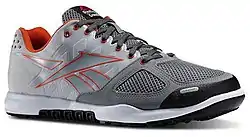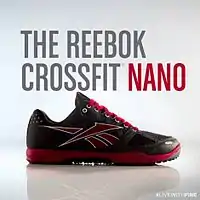Reebok Nano
The Reebok Nano is the first official athletic shoe specifically designed for CrossFit.[1][2] The first generation of the shoe was released in 2011.[1]
 | |
| Product type | Sneakers |
|---|---|
| Owner | Reebok |
| Introduced | 2011 |
| Markets | Worldwide |
| Website | reebok.com/nano |
Product history
Reebok Nano

Reebok became the official provider of licensed CrossFit footwear and apparel in 2011.[1] That year, Reebok released the first Reebok Nano. The shoe was designed to be used for high impact movements, weightlifting and short-distance running.[3] The shoe's design includes a spacious toe box.[4]
Reebok Nano 2.0
The following year the Nano 2.0 was released.[5] Men's Fitness included the shoe on its list of "Workout Gear for CrossFit: 15 New Products to Improve Your Daily Workout."[6] The shoe has a wider toe box than the first generation to allow an athlete's foot to splay more naturally and maximize stability.
Reebok Nano 3.0
The Nano 3.0 was introduced in 2013. The shoe provides forefoot cushioning and heel stabilization with its dual density platform. The shoe has a protective layer in its midsole to prevent fraying caused by rope climbs and features a wide toe box and midsole to provide stability during lifts.[7] The Nano 3.0 also introduced the DuraCage construction for additional protection and lightweight support.

Reebok Nano 4.0
The fourth generation of the shoe was introduced during the 2014 CrossFit Games.[8] The front of the shoe has a duracage protection layer and enhanced toe-wrap for durability.[9] It also features a rigid sole that provides more grip and stability than the previous Nano models.[9]
Reebok Nano 5.0
The fifth generation of the shoe. This generation of the shoe is wrapped in Kevlar.
Reebok Nano 6.0
Specifications:
- New DuPont™ Kevlar® infused mesh upper
- NEW Anatomically secure fit
- Polyurethane NanoShell for protection and support during heavy lifts
- NEW Kevlar fiber and Rope-Pro+ exterior material for greater grip on rope climbs
- Raised outsole lug patterns for better surface area contact and improved traction
- 3MM heel drop platform for improved stability during any WOD
Reebok Nano 7.0
Specifications:
- Crossfit / Weightlifting / Cross-training shoe - New for 2017
- NanoWeave technology on the upper for comfort and breathability
- Anatomical toe box and a low-cut design for a natural feel and ankle mobility
- Ortholite sockliner for cushion
- 360-degree TPU heel wrap for a locked-in feel
- Crystallized rubber outsole flexes naturally for balance and stability
- 4MM heel-to-toe drop
- Anatomically secure fit
Reebok Nano 8.0
Specifications:
- Crossfit / Weightlifting / Cross-training shoe - New for 2018
- NEW Flexweave Upper - Figure 8 construction for improved breathability, flexibility, and durability
- NEW Interior Bootie Construction for added comfort
- Strong Foundation with wide, anatomical toe box
- Minimal Drop Outsole for secure footing
- Low-cut design for a natural feel and ankle mobility
- RopePro tech for greater traction and protection on rope climbs
References
- Cary Castagna (September 2, 2014). "Reebok powers up the perfect CrossFit shoe". Retrieved February 10, 2015.
- Gabriel Simon. "Which Reebok CrossFit shoe is best for you?". Retrieved February 10, 2015.
- Kate Brierley (March 23, 2014). "The Best Women's Shoes for CrossFit Training". Retrieved February 10, 2015.
- Riley Jones (August 23, 2013). "Know Your Tech: Reebok U-Form". Retrieved February 10, 2015.
- "Cross Training Shoe Guide". Archived from the original on August 22, 2014. Retrieved February 10, 2015.
- Mattie Schuler. "Workout Gear For CrossFit:15 Products to Improve Your Daily Workout". Retrieved February 10, 2015.
- "Reebok CrossFit Nano 3.0 vs. Nano Speed". February 4, 2014. Retrieved February 10, 2015.
- "Review: Reebok CrossFit Nano 4.0". Retrieved February 10, 2015.
- Christopher Turner (October 6, 2014). "Editor's Pick: Reebok Nano 4.0". Retrieved February 10, 2015.
